The rise of China and the fall of open access
The title of Open Access Week 2025 is “Who Owns Our Knowledge?”. The answer is increasingly likely to be “China”.
Hello fellow journalologists,
At the start of the year I created a video that looked back over the past 25 years of scholarly publishing (2000 to 2024). Now that we’re in Q4 of 2025 I thought I’d crunch the numbers again and outline this year’s high-level trends.
It won’t surprise you to hear that 2025 has been another year of rapid article growth. Figure 1 shows the volume of research articles1 published between 2000 and 2025. The 2025 number is a guesstimate, calculated using a simple run rate.2
[All the graphs in this article use data from Dimensions, Digital Science.]
To get a better sense of the rate of growth each year, we can plot the year-on-year increase in research articles; around 370,000 additional research articles will be published in 2025 compared with 2024, using the run-rate methodology.
However, the 370,000 figure is almost certainly a significant underestimate and is an artefact of the overly simplistic extrapolation method that I used; a year-on-year growth of more than 500,000 articles seems more likely, a higher figure than during the pandemic.3
The rapid growth in research article output has one primary driver: China.
The scientific hegemony that the USA had for decades has gone, probably never to be replaced.
The swing over the past decade is stark. In 2016 the percentage of papers with a Chinese author was 13%, with the USA at 17%. In 2025 China is at 23%, with the USA dropping to 11%.
How is the open access transition faring?
Dimensions uses the Unpaywall definitions to assign an access status to articles; the Unpaywall categories are mutually exclusive and so each research article is assigned to only one of the five categories. The graph below shows the relative proportion of the five classifications for research articles, globally, between 2000 and 2025.
The proportion of research articles published under the Gold model has fallen in 2025, compared with 2024, but the proportion of hybrid articles has increased slightly.
It’s worth noting that the proportion of Closed articles in 2025 is similar to 2024. The steady transition to open access, which ran through to 2023, appears to have stalled and perhaps even reversed if “Gold” is the ultimate goal.
Weaving the two threads together
The rapid growth of research article output from China is affecting the global transition to open access; Chinese researchers rarely publish open access in hybrid journals — presumably due to a lack of transformative agreements — preferring fully open access journals (occasionally) or subscription journals (often).
It’s worth noting that 60% of research articles that have at least one author from China are Closed access (Figure 5; above). By contrast only a third of articles that do not have any authors from China are published in Closed journals (Figure 6; below).4
This week Delta Think released their (always excellent) annual analysis of the open access market. They predict that the proportion of articles published under a hybrid open access model globally will increase in the coming years. Dan Pollock and Heather Staines write:
Hybrid output and revenue continue to rise, outpacing the broader market and poised to represent a sizeable portion of OA revenues within the next two years. We estimate that by 2027, hybrid could make up one-third of OA output and account for nearly half of OA market value-- a reflection of higher prices and a shift in author preference toward more established publishing venues.
Based on the data I’ve presented here, that could be a bullish take; China will need to adopt transformative agreements at scale for hybrid open access to increase significantly, globally. China’s market dominance in terms of article output is simply too large for it to be otherwise.
Conclusions
The title of Open Access Week 2025 is “Who Owns Our Knowledge?”. The answer is increasingly likely to be “China”.
A faster global transition to open access is only possible if Chinese researchers change their publishing habits and choose ‘open’ much more frequently than they do now.
For that to happen, there’s a big financial challenge to overcome. Historically, China has paid far less in institutional ‘read’ subscription fees than the likes of the USA, Japan, and western European countries. Publishing a higher proportion of papers open access would become very expensive for China as article output increases further. Publishing papers ‘Closed’ for free could be an appealing option.
Western publishers and editors may start to feel increasingly aggrieved at being expected to process lots of extra submissions from China, which they struggle to find peer reviewers for (not least because Chinese researchers carry less of the peer review burden than researchers in the USA and Europe); are expensive to check for integrity issues; and are challenging to monetise adequately.
Western news coverage this year has understandably focused on the disruption to the US research enterprise. However, the future of research was always going to be dominated by China; recent events in the USA have simply helped to tip the balance of scientific power towards China, faster.
If you have any questions or comments you can click the title at the top of this email and you’ll be taken to the new Substack website. I’m very interested to hear what Journalology readers conclude from this analysis.
Until next time,
James
P.S. If you enjoyed this article please do share it with your colleagues and encourage them to subscribe.
I applied the filters Research Article [Document Type] AND Article [Publication Type] in Dimensions.
The data presented here are based on Dimensions searches performed on 23 October 2025. The run rate was calculated by multiplying the article counts by 12/9 (i.e. divide by 9 and multiply by 12). This is a rough and ready calculation, but it should give us a reasonable indication of how the year is likely to pan out.
When I recorded the video in February 2025 Dimensions had around 150,000 more research articles in its database in 2024 compared with 2025. That figure increased to just shy of 370,000 when I queried the database yesterday. Some publishers are slow to provide indexers with data, which makes it very hard to predict what the article volumes will be in a calendar year. I suggest you read Eric Schares’ essay to learn more.
This graph uses a Dimensions search that excludes any research article with at least one author based in China (i.e. NOT China)


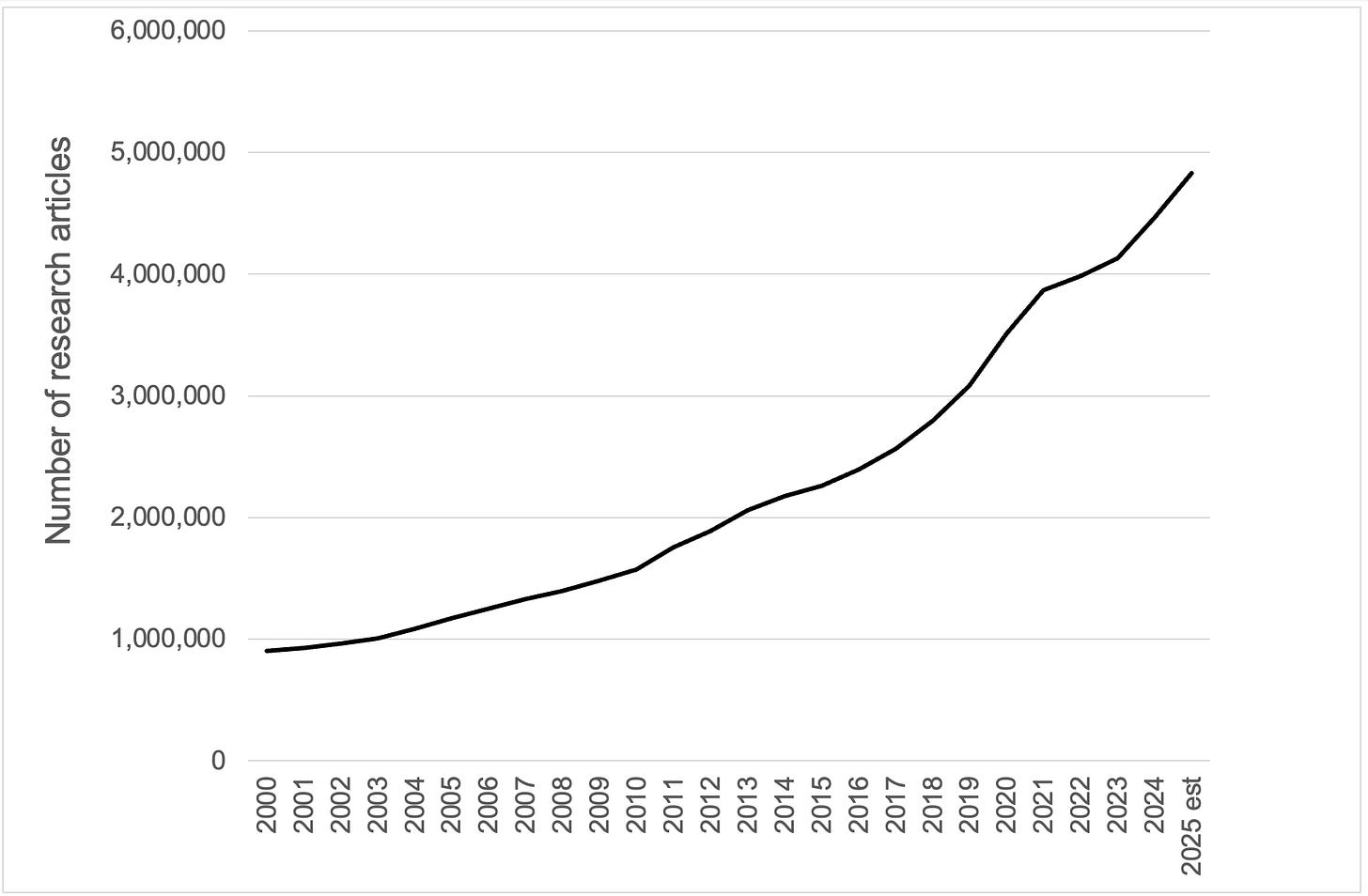
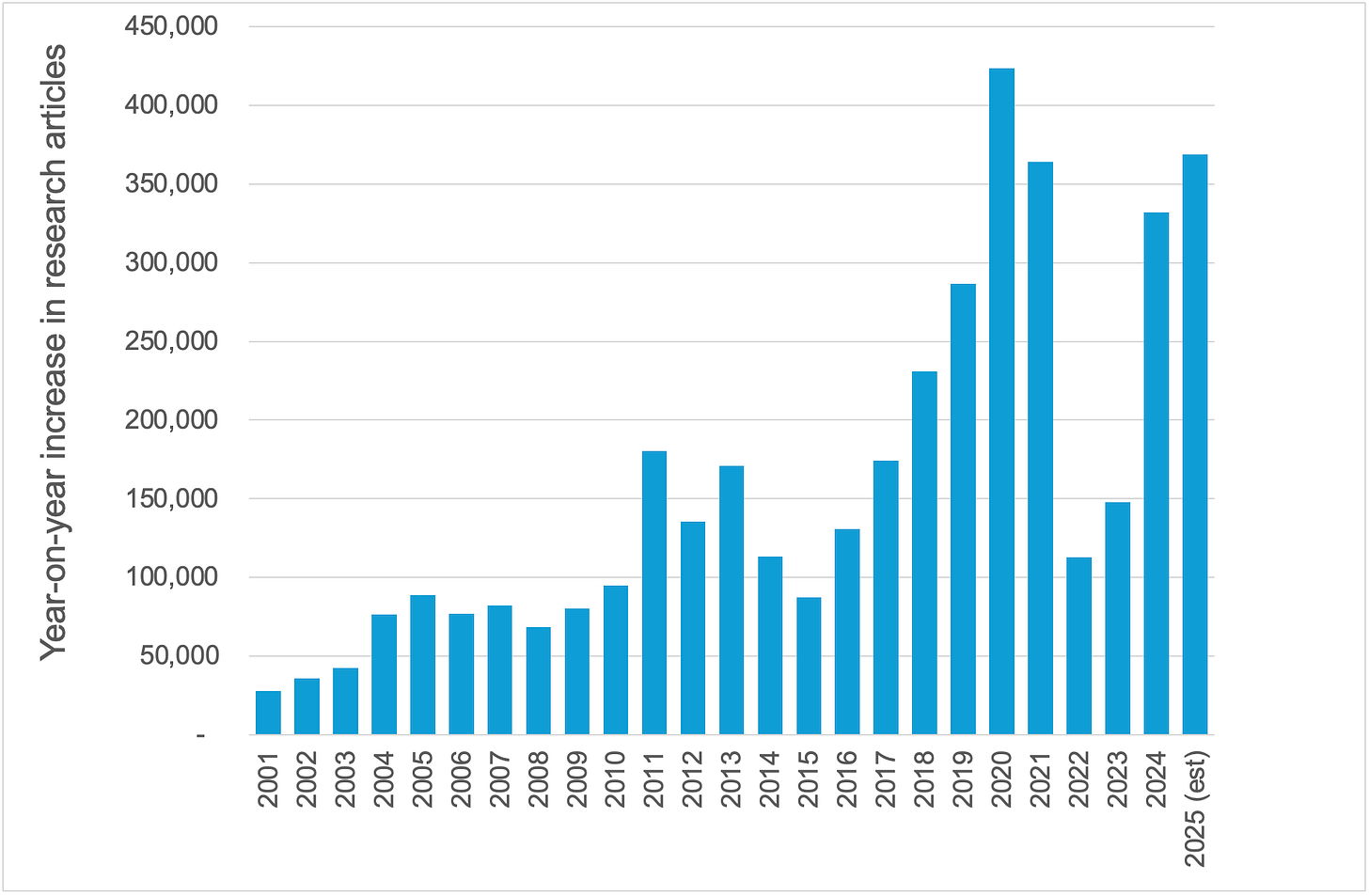
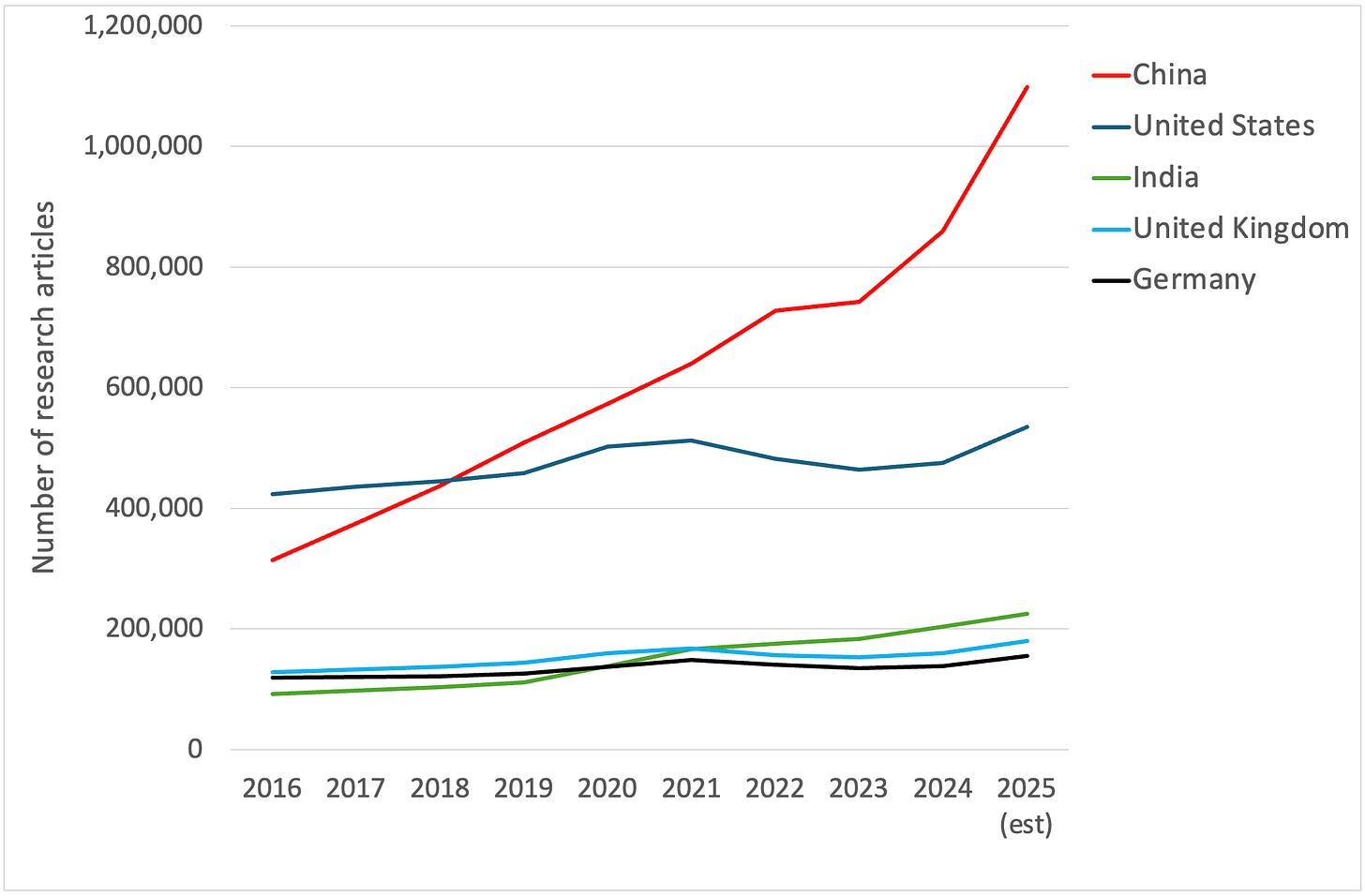

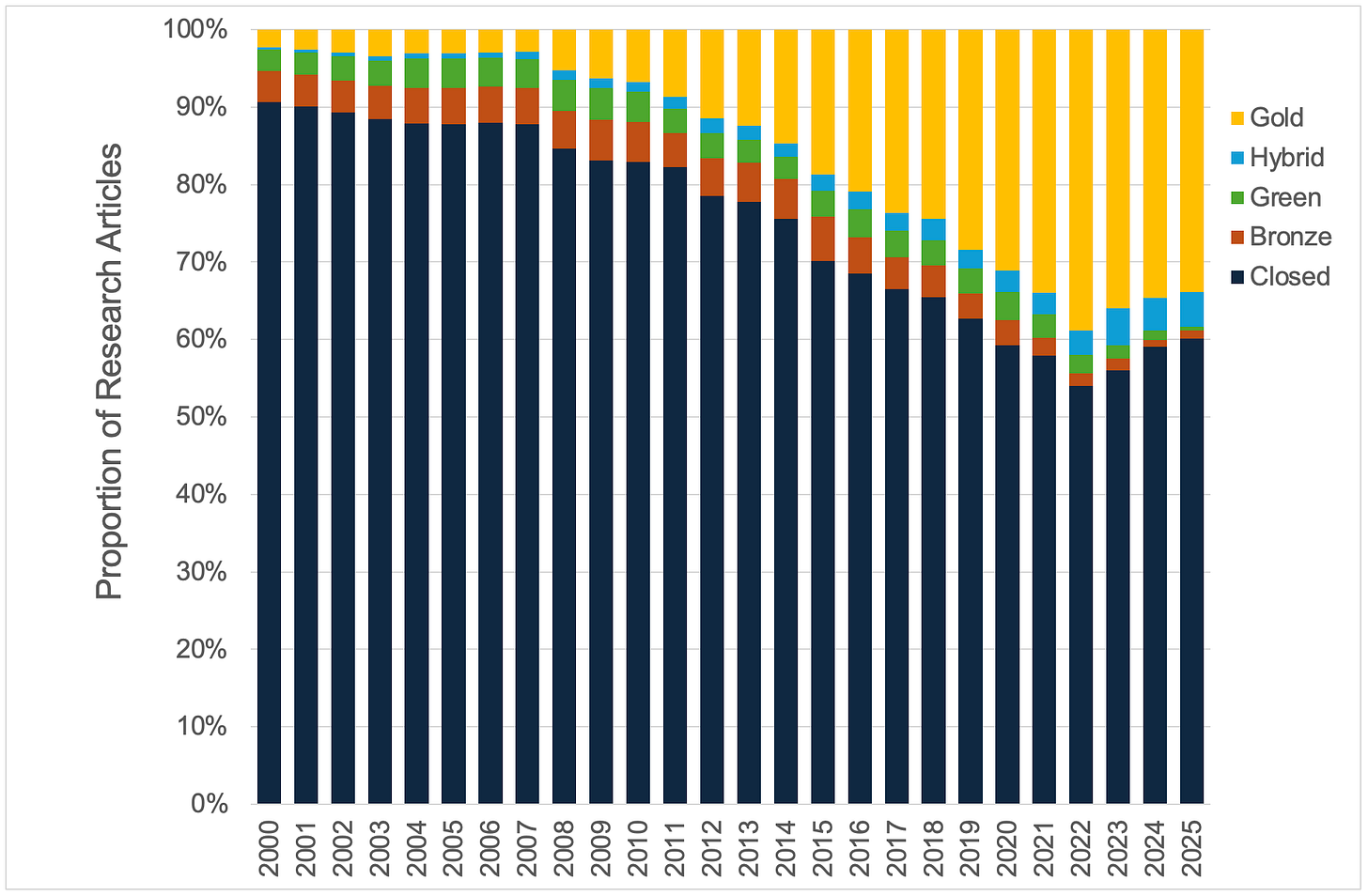
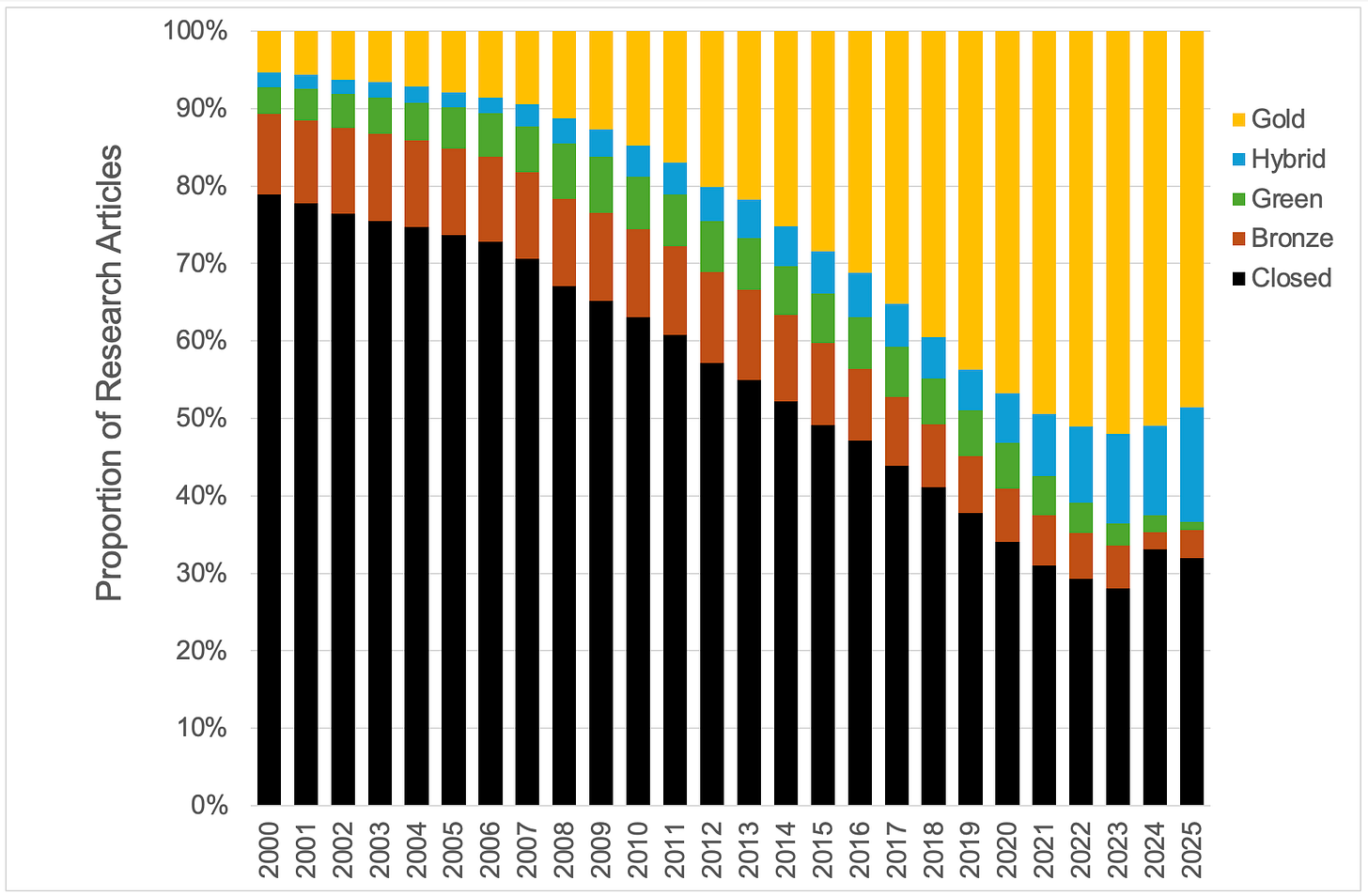
The decline in gold OA is clearly a result of librarians choosing read&publish agreements over supporting full open access publishers, which is frankly a scandal. Scientists should be up in arms over it. Very shortsighted.
Great insight, James! Coming at the end of a complex business week, your article helps me set the stage for further conversations on Monday.